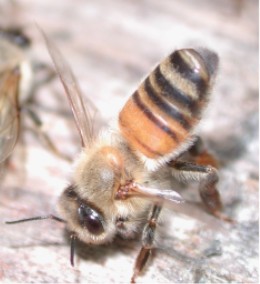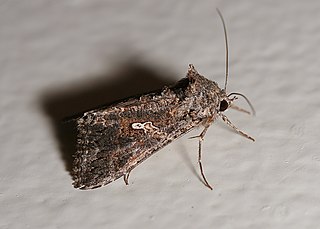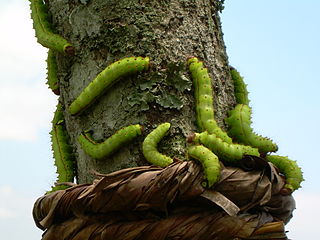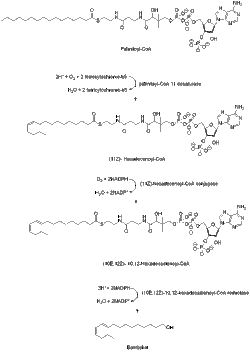
Bombyx mori, commonly known as the domestic silk moth, is a moth species belonging to the family Bombycidae. It is the closest relative of Bombyx mandarina, the wild silk moth. Silkworm are the larvae of silk moths. The silkworm is of particular economic value, being a primary producer of silk. The silkworm's preferred food are the leaves of white mulberry, though they may eat other species of mulberry, and even leaves of other plants like the osage orange. Domestic silk moths are entirely dependent on humans for reproduction, as a result of millennia of selective breeding. Wild silk moths, which are other species of Bombyx, are not as commercially viable in the production of silk.

A pheromone is a secreted or excreted chemical factor that triggers a social response in members of the same species. Pheromones are chemicals capable of acting like hormones outside the body of the secreting individual, to affect the behavior of the receiving individuals. There are alarm pheromones, food trail pheromones, sex pheromones, and many others that affect behavior or physiology. Pheromones are used by many organisms, from basic unicellular prokaryotes to complex multicellular eukaryotes. Their use among insects has been particularly well documented. In addition, some vertebrates, plants and ciliates communicate by using pheromones. The ecological functions and evolution of pheromones are a major topic of research in the field of chemical ecology.

Adolf Friedrich Johann Butenandt was a German biochemist. He was awarded the Nobel Prize in Chemistry in 1939 for his "work on sex hormones." He initially rejected the award in accordance with government policy, but accepted it in 1949 after World War II. He was President of the Max Planck Society from 1960 to 1972. He was also the first, in 1959, to discover the structure of the sex pheromone of silkworms, which he named bombykol.

The cabbage looper is a medium-sized moth in the family Noctuidae, a family commonly referred to as owlet moths. Its common name comes from its preferred host plants and distinctive crawling behavior. Cruciferous vegetables, such as cabbage, bok choy, and broccoli, are its main host plant; hence, the reference to cabbage in its common name. The larva is called a looper because it arches its back into a loop when it crawls.
A semiochemical, from the Greek σημεῖον (semeion), meaning "signal", is a chemical substance or mixture released by an organism that affects the behaviors of other individuals. Semiochemical communication can be divided into two broad classes: communication between individuals of the same species (intraspecific) or communication between different species (interspecific).
Fatty acid desaturases are a family of enzymes that convert saturated fatty acids into unsaturated fatty acids and polyunsaturated fatty acids. For the common fatty acids of the C18 variety, desaturases convert stearic acid into oleic acid. Other desaturases convert oleic acid into linolenic acid, which is the precursor to alpha-linolenic acid, gamma-linolenic acid, and eicosatrienoic acid.

The Bombycidae are a family of moths known as silkworm moths. The best-known species is Bombyx mori (Linnaeus), or domestic silk moth, native to northern China and domesticated for millennia. Another well-known species is Bombyx mandarina, also native to Asia.
In biochemistry, fatty acid synthesis is the creation of fatty acids from acetyl-CoA and NADPH through the action of enzymes called fatty acid synthases. This process takes place in the cytoplasm of the cell. Most of the acetyl-CoA which is converted into fatty acids is derived from carbohydrates via the glycolytic pathway. The glycolytic pathway also provides the glycerol with which three fatty acids can combine to form triglycerides, the final product of the lipogenic process. When only two fatty acids combine with glycerol and the third alcohol group is phosphorylated with a group such as phosphatidylcholine, a phospholipid is formed. Phospholipids form the bulk of the lipid bilayers that make up cell membranes and surrounds the organelles within the cells. In addition to cytosolic fatty acid synthesis, there is also mitochondrial fatty acid synthesis (mtFASII), in which malonyl-CoA is formed from malonic acid with the help of malonyl-CoA synthetase (ACSF3), which then becomes the final product octanoyl-ACP (C8) via further intermediate steps.

Bombyx mandarina, the wild silk moth, is a species of moth in the family Bombycidae. It is the closest relative of Bombyx mori, the domesticated silk moth. The silkworm is the larva or caterpillar of a silk moth. Unlike the domesticated relative which is unable to fly or indeed persist outside human care, the wild silk moth is a fairly ordinary lepidopteran. Its main difference from the domesticated taxon is the more slender body with well-developed wings in males, and the dull greyish-brown colour.
Sex pheromones are pheromones released by an organism to attract an individual of the same species, encourage them to mate with them, or perform some other function closely related with sexual reproduction. Sex pheromones specifically focus on indicating females for breeding, attracting the opposite sex, and conveying information on species, age, sex and genotype. Non-volatile pheromones, or cuticular contact pheromones, are more closely related to social insects as they are usually detected by direct contact with chemoreceptors on the antennae or feet of insects.

In enzymology, an acyl-[acyl-carrier-protein] desaturase (EC 1.14.19.2) is an enzyme that catalyzes the chemical reaction

Stearoyl-CoA desaturase (Δ-9-desaturase) is an endoplasmic reticulum enzyme that catalyzes the rate-limiting step in the formation of monounsaturated fatty acids (MUFAs), specifically oleate and palmitoleate from stearoyl-CoA and palmitoyl-CoA. Oleate and palmitoleate are major components of membrane phospholipids, cholesterol esters and alkyl-diacylglycerol. In humans, the enzyme is present in two isoforms, encoded respectively by the SCD1 and SCD5 genes.
Chemosensory proteins (CSPs) are small soluble proteins which mediate olfactory recognition at the periphery of sensory receptors in insects, similarly to odorant-binding proteins. The typical structure of CSPs is made of six or seven α-helical chains of about 110-120 amino acids, including four cysteines that build two small loops, two adjacent disulfide bridges, and a globular "prism-like" functional structure [5]. Three CSP structures have been solved in moths and locusts [5-8].

Lathosterol oxidase is a Δ7-sterol 5(6)-desaturase enzyme that in humans is encoded by the SC5D gene.

Wild silks have been known and used in many countries from early times, although the scale of production is far smaller than that from cultivated silkworms. Silk cocoons and nests often resemble paper or cloth, and their use has arisen independently in many societies.
The pheromone biosynthesis activation neuropeptide (PBAN) is a neurohormone that activates the biosynthesis of pheromones in moths. Female moths release PBAN into their hemolymph during the scotophase to stimulate the biosynthesis of the unique pheromone that will attract the conspecific males. PBAN release is drastically reduced after mating, contributing to the loss in female receptivity. In black cutworm, it has been shown that the juvenile hormone helps induce release of PBAN which goes on to influence pheromone production and responsiveness in females and males, respectively. In the oriental tobacco budworm, the circadian rhythm of pheromone production is closely associated with PBAN release.
The Bombyx hybrid is a hybrid between a male Bombyx mandarina moth and a female Bombyx mori moth. They produce larvae called silkworms, like all species of Bombyx. The larvae look a lot like the other variations. They are brown in the first half and gray at the bottom half, but they get larger black spots than other variations. Generally, they look like a normal Bombyx moth, but a bit darker. Hybrids are not used for silk, but for research. Because Bombyx mori males lost their ability to fly, their females are much more likely to mate with a male Bombyx mandarina. The reverse is possible, but both species have to be kept in the same container. Since Bombyx hybrids are much more common than the other variation, more is known about them.
Delta12-fatty-acid desaturase (EC 1.14.19.6, Delta12 fatty acid desaturase, Delta12(omega6)-desaturase, oleoyl-CoA Delta12 desaturase, Delta12 desaturase, Delta12-desaturase) is an enzyme with systematic name acyl-CoA,hydrogen donor:oxygen Delta12-oxidoreductase. This enzyme catalyses the following chemical reaction
Nebraskanic acid is a 24-carbon dihydroxy fatty acid with the chemical formula C
24H
46O
4 and molecular weight 398.6 g/mol.

Insect pheromones are neurotransmitters that serve the chemical communication between individuals of an insect species. They thus differ from kairomones, in other words, neurotransmitters that transmit information to non-species organisms. Insects produce pheromones in special glands and release them into the environment. In the pheromone receptors of the sensory cells of the recipient, they produce a nerve stimulus even in very low concentrations, which ultimately leads to a behavioral response. Intraspecific communication of insects via these substances takes place in a variety of ways and serves, among other things, to find sexual partner, to maintain harmony in a colony of socially living insects, to mark territories or to find nest sites and food sources.











